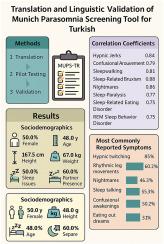Munich Parasomnia筛选工具在土耳其语中的翻译及语言验证研究
IF 3.4
2区 医学
Q1 CLINICAL NEUROLOGY
引用次数: 0
摘要
睡眠异常是一种常见的睡眠障碍,经常被忽视,对个人的睡眠质量和日常功能有重大影响。本研究的目的是翻译和文化适应慕尼黑睡眠障碍筛查(MUPS)量表到土耳其,并评估MUPS- tr的心理测量特性。方法以311名土耳其语成人为研究对象。MUPS量表采用前向向后翻译法改编成土耳其语,并以专家意见确保内容效度。最后的文本是在试验之后得到的。对40名双语被试进行重测分析,采用Cronbach’s α系数评价内部一致性。此外,使用Spearman相关评估时间依赖性一致性。还分析了症状出现的频率。在参与研究之前,所有参与者都获得了书面知情同意书。结果总量表的内部一致性系数为Cronbach’s α = 0.87。重测相关性从Spearman的r = 0.76到0.88不等。双语参与者的跨语言项目相关性在0.79 ~ 0.88之间。最常见的症状是睡眠抽搐(85%)、噩梦(46.3%)和有节奏的腿部运动(60.2%)。结论MUPS-TR仪器是一种有效、可靠的快速筛查突厥语成人睡眠异常症状的工具。它在临床实践中的功效是特别明显的,特别是在初步评估和转诊过程的领域。本文章由计算机程序翻译,如有差异,请以英文原文为准。

Translation and linguistic validation study of Munich Parasomnia Screening tool for Turkish
Background
Parasomnias are prevalent sleep disorders that frequently go unrecognized and can have a substantial impact on an individual's sleep quality and daily functioning. The objective of this study was to translate and culturally adapt the Munich Parasomnia Screening (MUPS) scale into Turkish and to evaluate the psychometric properties of the MUPS-TR.
Methods
The present study was conducted with a sample of 311 adult Turkish-speaking individuals. The MUPS scale was adapted into Turkish using the forward-backward translation method, and content validity was ensured with expert opinions. The final text was obtained subsequent to the pilot test. A test-retest analysis was conducted with 40 bilingual participants, and internal consistency was assessed using Cronbach's α coefficient. Additionally, time-dependent consistency was assessed using Spearman's correlation. The frequency of symptoms was also analyzed. Prior to their involvement in the study, written informed consent was obtained from all participants.
Results
The internal consistency coefficient for the total scale was calculated as Cronbach's α = 0.87. The test-retest correlations ranged from Spearman's r = 0.76 to 0.88. Cross-language item correlations in bilingual participants ranged from 0.79 to 0.88. The most prevalent symptoms were identified as hypnic twitching (85 %), nightmares (46.3 %), and rhythmic leg movements (60.2 %).
Conclusions
The MUPS-TR instrument is a valid and reliable tool for rapid screening of parasomnia symptoms in Turkish-speaking adults. Its efficacy in clinical practice is particularly pronounced, especially in the domains of initial assessment and referral processes.
求助全文
通过发布文献求助,成功后即可免费获取论文全文。
去求助
来源期刊

Sleep medicine
医学-临床神经学
CiteScore
8.40
自引率
6.20%
发文量
1060
审稿时长
49 days
期刊介绍:
Sleep Medicine aims to be a journal no one involved in clinical sleep medicine can do without.
A journal primarily focussing on the human aspects of sleep, integrating the various disciplines that are involved in sleep medicine: neurology, clinical neurophysiology, internal medicine (particularly pulmonology and cardiology), psychology, psychiatry, sleep technology, pediatrics, neurosurgery, otorhinolaryngology, and dentistry.
The journal publishes the following types of articles: Reviews (also intended as a way to bridge the gap between basic sleep research and clinical relevance); Original Research Articles; Full-length articles; Brief communications; Controversies; Case reports; Letters to the Editor; Journal search and commentaries; Book reviews; Meeting announcements; Listing of relevant organisations plus web sites.
 求助内容:
求助内容: 应助结果提醒方式:
应助结果提醒方式:


